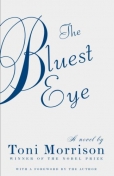BKMT READING GUIDES
The Bluest Eye (Vintage International)
by Toni Morrison
Paperback : 206 pages
49 clubs reading this now
11 members have read this book
New York Times Bestseller
Pecola Breedlove, a young black girl, prays every day for beauty. Mocked by other children for the dark skin, curly hair, and brown eyes that set her apart, she yearns for normalcy, for the blond hair and blue eyes that she believes will allow her to finally fit ...
Introduction
New York Times Bestseller
Pecola Breedlove, a young black girl, prays every day for beauty. Mocked by other children for the dark skin, curly hair, and brown eyes that set her apart, she yearns for normalcy, for the blond hair and blue eyes that she believes will allow her to finally fit in.Yet as her dream grows more fervent, her life slowly starts to disintegrate in the face of adversity and strife. A powerful examination of our obsession with beauty and conformity, Toni Morrison’s virtuosic first novel asks powerful questions about race, class, and gender with the subtlety and grace that have always characterized her writing.
"You can't go wrong by reading or re-reading the collected works of Toni Morrison. Beloved, Song of Solomon, The Bluest Eye, Sula, everything else — they're transcendent, all of them. You’ll be glad you read them."--Barack Obama
Discussion Questions
1. The novel opens with an excerpt from an old-fashioned reading primer. The lines begin to blur and run together—as they do at the beginning of select chapters. What social commentary is implicit in Morrison's superimposing these bland banalities describing a white family and its activities upon the tragic story of the destruction of a young black girl? How does Morrison's powerful language—both highly specific and lyrical—comment on the inadequacy of "correct" English and the way in which it masks and negates entire worlds of beauty and pain?2. "Quiet as it's kept, there were no marigolds in the fall of 1941. We thought, at the time, that it was because Pecola was having her father's baby that the marigolds did not grow." With these lines Morrison's child narrator, Claudia MacTeer, invites the reader into a troubling community secret: the incestuous rape of her 11-year-old friend Pecola Breedlove. What are the advantages of telling Pecola's story from a child's point of view? Claudia would appear to connect the barrenness of the land to Pecola's tragedy. In what ways does Morrison show how Pecola's environment—and American society as a whole—are hostile to her very existence?
3. The title of the novel refers to Pecola Breedlove's intense desire for blue eyes. She believes herself ugly and unworthy of love and respect, but is convinced that her life would be magically transformed if she possessed blue eyes. How does racial self-loathing corrode the lives of Pecola and her parents, Cholly and Pauline Breedlove? How does racial self-hatred manifest itself in characters like Maureen Peal, Geraldine, and Soaphead Church?
4. At a certain point in the novel, Morrison, through her narrator, states that romantic love and physical beauty are "probably the most destructive ideas in the history of human thought." How do the lives of individual characters bear out that statement? To what degree are these two concepts generated from within or imposed on us by society? Where do the characters first encounter ideas of romantic love and beauty—ideas which will eventually torture and exclude them? What positive visions of beauty and love does the novel offer?
5. What role does social class play in the novel? Pecola first comes to stay with the MacTeers because her family has been put "outdoors" owing to her father's drunken violence and carelessness. The threat of "outdoors" focuses families like the MacTeers on upward mobility. "Being a minority in both caste and class we moved about anyway on the hem of life, struggling to consolidate our weaknesses and hang on, or to creep singly up into the folds of the garment." Is divisiveness one result of this upward striving Morrison describes? What are others?
6. The novel is set in a Midwestern industrial town, Lorain, Ohio, Morrison's own birthplace. Pauline and Cholly Breedlove are transplanted Southerners and several key scenes in the novel are set in the South. How does Morrison set up comparisons between a Northern black community and the Southern black way of life? What values have been lost in the migration north?
7. Consider Morrison's characterization of Cholly Breedlove. While she clearly condemns his actions, she resists dehumanizing him. If rape of one's daughter is an "unimaginable" crime, can one at least trace the events (and resulting emotions) that made it possible for Cholly to commit this brutal act? Is there a connection between the white hunters' "rape" of Cholly and the sexual aggression he eventually turned on his daughter?
8. The Bluest Eye was published in 1970. At the time Morrison was writing the novel, the racist society that condemned Pecola Breedlove was still very much in place and Morrison took great risks—both within the black community and American society as a whole—to tell this important story. While advances in civil rights and racial attitudes have been made in the intervening years, it is arguable that many of the core issues so vividly evoked in the novel remain. What evidence is there that racial self-hatred continues to ruin lives? What present-day cultural factors could contribute to tragedies like Pecola's?
Book Club Recommendations
Recommended to book clubs by 1 of 1 members.
Now serving over 80,000 book clubs & ready to welcome yours. Join us and get the Top Book Club Picks of 2022 (so far).
Get free weekly updates on top club picks, book giveaways, author events and more








